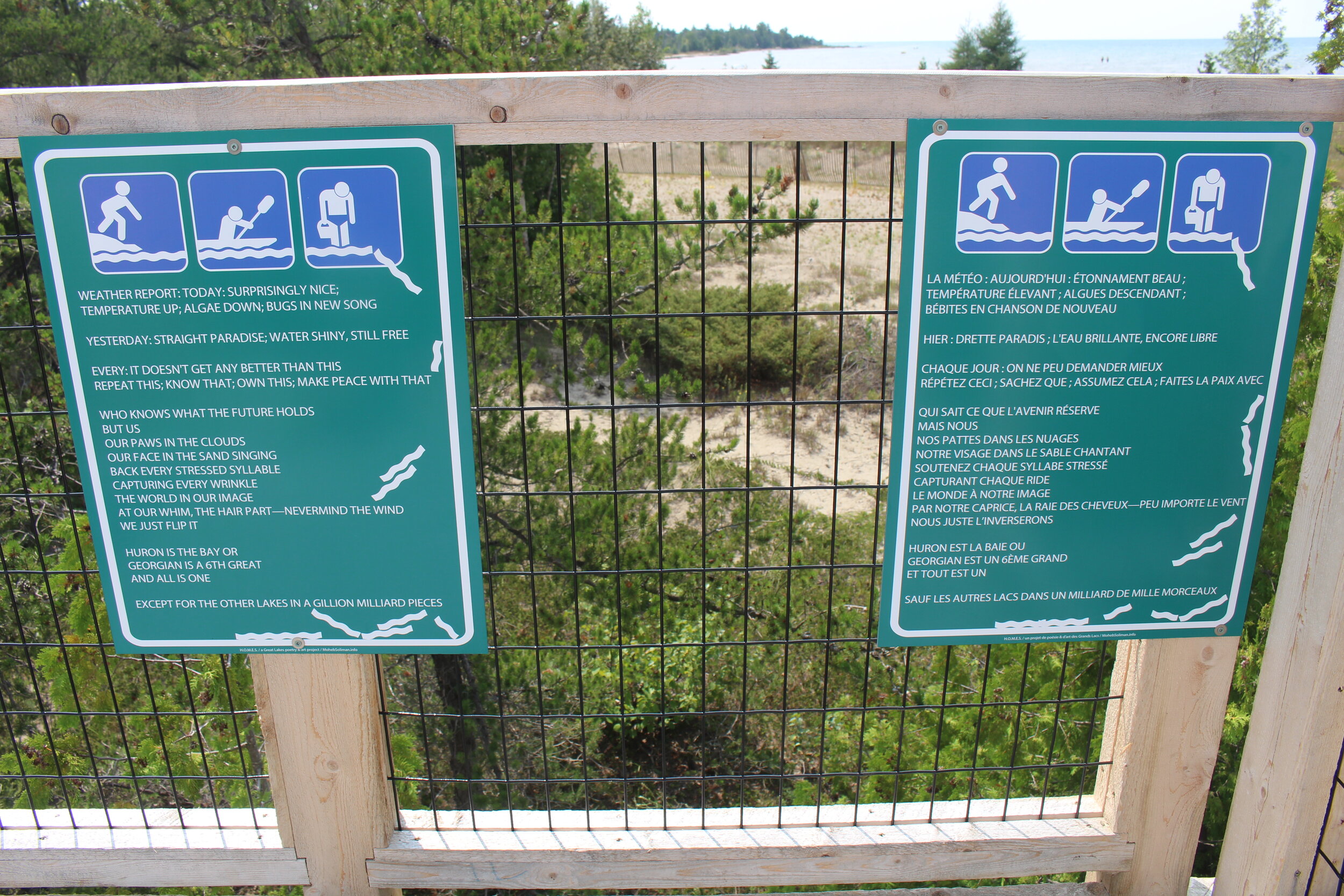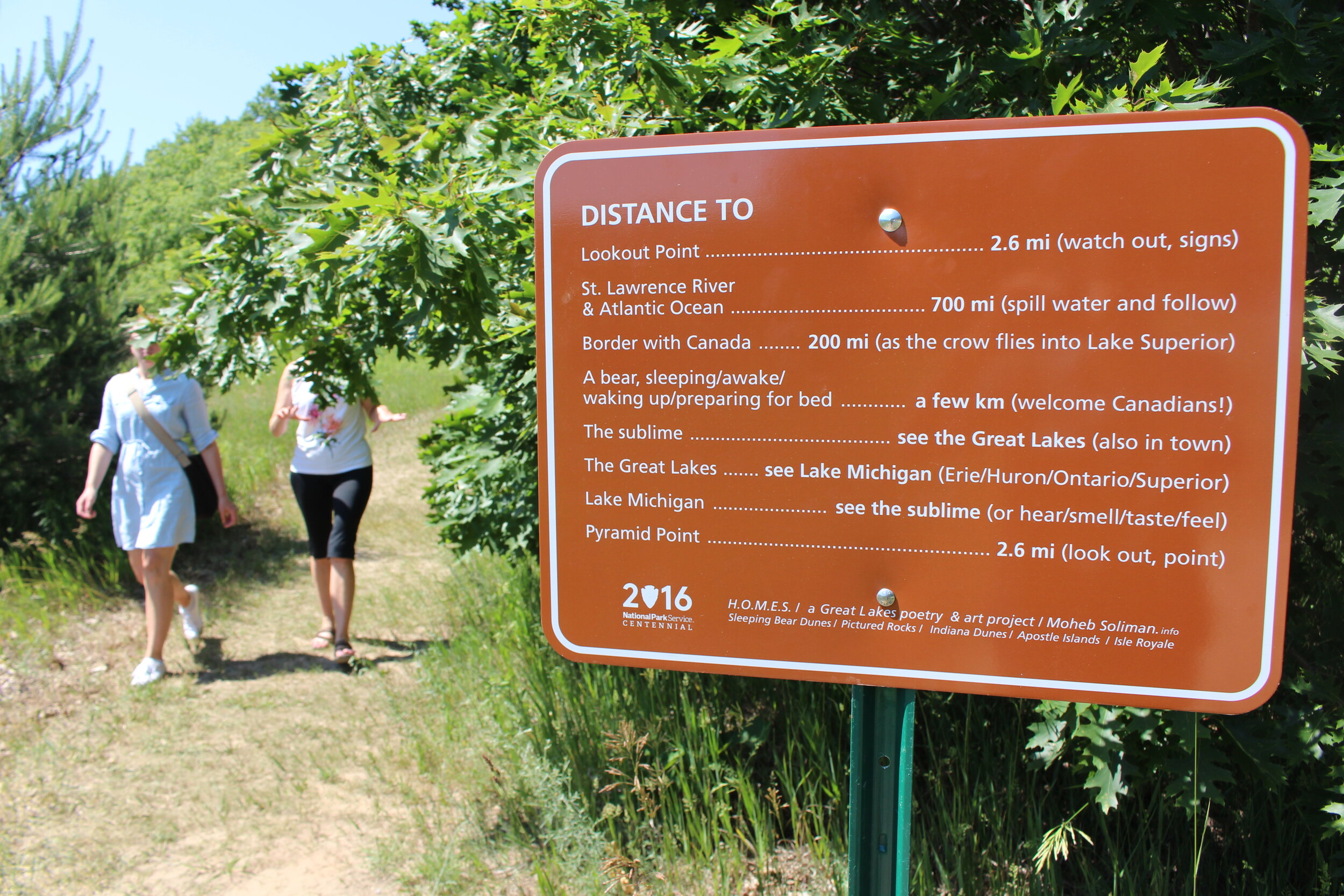Attention Visitors Attention
Postmodern nature poems hiding in plain sight as official signage in collaboration with US and Canadian Great Lakes national parks. See all the signs here. See the map below for locations.




Locations
APOSTLE ISLANDS / at Raspberry Island, Stockton Island campground and Julian Bay, Meyers Beach, Little Sand Bay
PICTURED ROCKS / at Sand Point Marsh Trail, Miners Castle, Hurricane River, Log Slide Overlook, Sable Falls Trail
SLEEPING BEAR DUNES / at North and South Manitou Islands, Leland dock, Good Harbor Bay Beach 669, Bay View Trail
INDIANA DUNES / at Douglas Center Miller Woods Trail, West Beach bathhouse and dune trail (same at Chellberg Farm trail), Portage Lakefront Riverwalk, Lake View Beach
ISLE ROYALE / at Windigo dock, Daisy Farm, Rock Harbor campground and America Dock, Ranger III ferry
CANADA / updated soon
Media
PBS MN Original segment, aired 4/17
More interviews and articles about this project
MI public radio / WI Public Radio & a related piece / Detroit News / Perfect Day Duluth / Glen Arbor Sun
About
Nature poetry has a rich heritage in the United States and is always being written anew as our relationship with nature evolves. Our national parks have also long partnered with artists through residencies, exhibitions, and public programs to take the subjects of nature, culture, and self and portray and investigate them together in unique ways for the broad public. The 2016 centennial anniversary of the National Park Service is an especially fitting moment to expand both of these traditions. The concept behind this project draws inspiration from poetry as a powerful yet intimate art form that can capture how we perceive the world around us always through language. It is also rooted in installation and performance art, which bring surprising encounters in the everyday world. Where park visitors expect signs to be informational, authoritarian, scientific, or historical, here, poetry reverses that and offers a subjective version of the same content. The poetic signs also explore what it means to commune with nature in places like national parks with other people and with wildlife, how officialdom and administrators also "see and feel" nature with us, and how contemporary poetry and art continue to experiment with addressing the natural world in our time.
This project comes out of poet and artist Moheb Soliman's larger interdisciplinary project, HOMES—the acronym for the Great Lakes (Huron, Ontario, Michigan, Erie, Superior) that evokes how these border lands and waters are home to millions of diverse people. Adding to previous writing and art work, in 2015 through a Joyce Foundation fellowship Moheb traced the entire Great Lakes coastline by land for four months, developing new work and partnerships with arts, environmental, native, and other organizations and groups who have varied stakes in the region. The Great Lakes are one body of water; one watershed; a wild, populous region with a distinct ecology, economy, and even history. But it’s also a borderland—the longest border between any two countries, and further divided as the territory of eight states and two provinces. It’s no wonder we don’t readily see it as a coherent whole. The poems in these signs play with blurring many boundaries—Canadian, American, Native, and immigrant; natural and cultural; romantic and technological; and more. Moheb’s HOMES project imagines the extent to which the Great Lakes region is “one place” where many different people sit around a common water table—living with, and not just on, the lakes, and nurturing a sense of belonging and identity oriented around a sublime natural sphere.
More at agreatlakesvista.tumblr.com
Thanks to parks staff members for creative & logistical support

